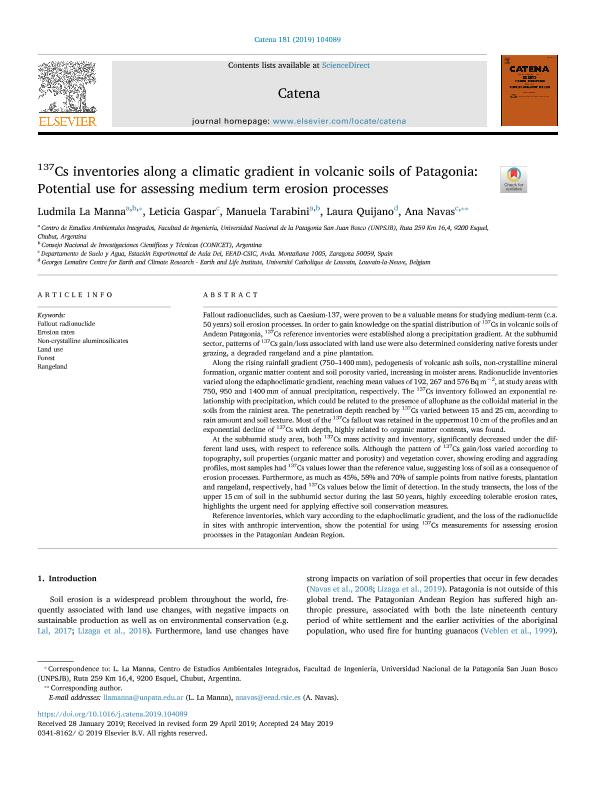Artículo
137Cs inventories along a climatic gradient in volcanic soils of Patagonia: Potential use for assessing medium term erosion processes
Fecha de publicación:
10/2019
Editorial:
Elsevier Science
Revista:
Catena
ISSN:
0341-8162
Idioma:
Inglés
Tipo de recurso:
Artículo publicado
Clasificación temática:
Resumen
Fallout radionuclides, such as Caesium-137, were proven to be a valuable means for studying medium-term (c.a. 50 years) soil erosion processes. In order to gain knowledge on the spatial distribution of 137Cs in volcanic soils of Andean Patagonia, 137Cs reference inventories were established along a precipitation gradient. At the subhumid sector, patterns of 137Cs gain/loss associated with land use were also determined considering native forests under grazing, a degraded rangeland and a pine plantation. Along the rising rainfall gradient (750–1400 mm), pedogenesis of volcanic ash soils, non-crystalline mineral formation, organic matter content and soil porosity varied, increasing in moister areas. Radionuclide inventories varied along the edaphoclimatic gradient, reaching mean values of 192, 267 and 576 Bq m−2 , at study areas with 750, 950 and 1400 mm of annual precipitation, respectively. The 137Cs inventory followed an exponential relationship with precipitation, which could be related to the presence of allophane as the colloidal material in the soils from the rainiest area. The penetration depth reached by 137Cs varied between 15 and 25 cm, according to rain amount and soil texture. Most of the 137Cs fallout was retained in the uppermost 10 cm of the profiles and an exponential decline of 137Cs with depth, highly related to organic matter contents, was found. At the subhumid study area, both 137Cs mass activity and inventory, significantly decreased under the different land uses, with respect to reference soils. Although the pattern of 137Cs gain/loss varied according to topography, soil properties (organic matter and porosity) and vegetation cover, showing eroding and aggrading profiles, most samples had 137Cs values lower than the reference value, suggesting loss of soil as a consequence of erosion processes. Furthermore, as much as 45%, 58% and 70% of sample points from native forests, plantation and rangeland, respectively, had 137Cs values below the limit of detection. In the study transects, the loss of the upper 15 cm of soil in the subhumid sector during the last 50 years, highly exceeding tolerable erosion rates, highlights the urgent need for applying effective soil conservation measures. Reference inventories, which vary according to the edaphoclimatic gradient, and the loss of the radionuclide in sites with anthropic intervention, show the potential for using 137Cs measurements for assessing erosion processes in the Patagonian Andean Region.
Archivos asociados
Licencia
Identificadores
Colecciones
Articulos(SEDE CENTRAL)
Articulos de SEDE CENTRAL
Articulos de SEDE CENTRAL
Citación
la Manna, Ludmila Andrea; Gaspar, Leticia; Tarabini, Manuela Mabel; Quijano, Laura; Navas, Ana; 137Cs inventories along a climatic gradient in volcanic soils of Patagonia: Potential use for assessing medium term erosion processes; Elsevier Science; Catena; 181; 104089; 10-2019; 1-11
Compartir
Altmétricas




